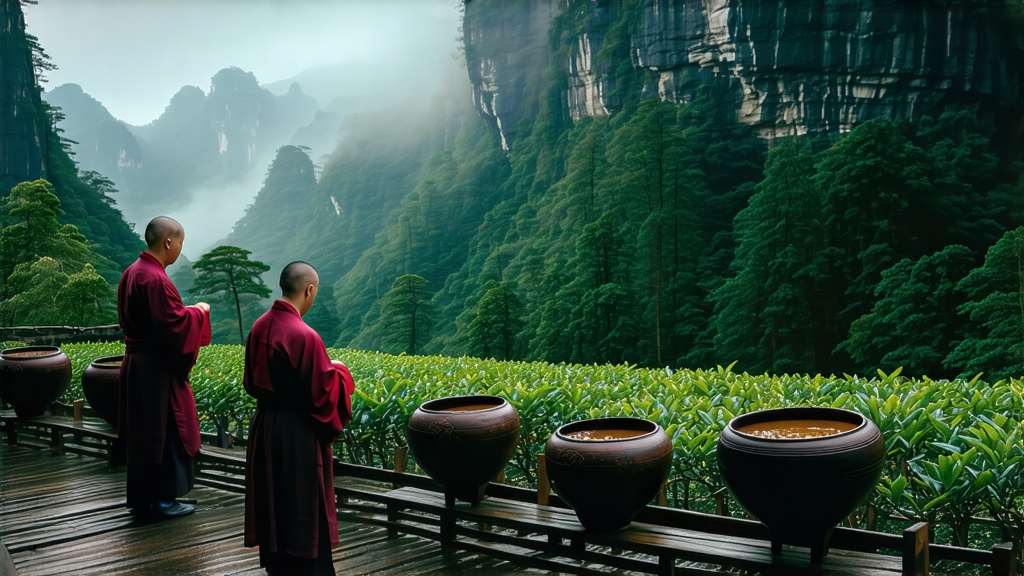
If green tea is the fresh-faced scholar of Chinese teas and pu-erh the venerable elder, then Da Hong Pao (Big Red Robe) is the dramatic actor who strides onstage in crimson silk, leaving the audience both awed and slightly mystified. Hailing from the jagged, mist-locked Wuyi Mountains of northern Fujian, this oolong commands prices that can outstrip gold, inspires legends of imperial tribute, and delivers a flavor so layered that professional tasters speak of “rock rhyme” (yanyun) as though describing a Beethoven sonata. For international drinkers accustomed to the grassy simplicity of sencha or the malt of Assam, Da Hong Pao is a gateway into the mineral, floral, and smoky complexity that only Chinese cliff tea (yancha) can provide.
A legend for every fold of rock
The most oft-repeated tale dates to the Ming dynasty: a Ming emperor’s mother lay gravely ill, and the court physicians were helpless. A passing monk from Wuyi plucked leaves from six bushy trees growing out of a nearly inaccessible cliff, brewed them into a dark amber liquor, and restored the empress to health. Overjoyed, the emperor sent bolts of scarlet silk to drape over the bushes in gratitude—hence “Big Red Robe.” While historians debate the dynastic details, the six mother trees still stand today in Jiulongke ravine, guarded by cameras and government decree. Since 2006 picking from them has been outlawed; the last 20 g of their leaf auctioned for over US $30,000, making earlier harvests relics worthy of a museum. Fortunately, centuries of grafting have spread their genetic legacy across the Wuyi micro-region, so modern drinkers can taste “xiaohongpao” (cuttings from the mothers) without auction-house drama.
Terroir: when rocks breathe into tea
Wuyi’s Danxia landform—purple-red sandstone and conglomerate cliffs—absorbs daytime heat and releases it at night, creating drastic diurnal swings. Frequent fog limits direct sunlight, forcing tea bushes to develop more chlorophyll and amino acids. Rainwater trickles through mineral-rich strata, picking up calcium, magnesium, and potassium before reaching the shallow, rocky soil. The result is a leaf laden with aromatic precursors that translate into the celebrated “rock bone and floral heart.” Locals insist that if you chew a fresh leaf straight from the cliff, you taste wet stone before any vegetal note—an instant geology lesson.
Three grades, three stories
- Mother-tree Da Hong Pao: essentially unavailable; exists as liquid history in private collections.
- Purebred qidan (strange sprout): direct first-generation cuttings from the mothers, cultivated in the core “zhengyan” 8 km² zone. Limited to a few hundred kilos per year, these lots carry authentication certificates and QR-coded provenance.
- Commercial blended DHP: skillfully assembled from several Wuyi cultivars (often qidan, beidou, and queshe) to approximate the mother-tree profile. When artfully done, it delivers 80 % of the experience at 5 % of the price, making it the bottle that most drinkers actually open.
Craft: where chemistry meets choreography
Harvesting occurs only in spring, ideally after the first sustained warm spell but before the torrential Mei-yu rains. Two leaves and a bud are snapped, not cut, to keep cell walls intact. The day’s pick must reach the village workshop by dusk, beginning the 18-hour marathon that converts fresh leaf into strip-shaped oolong.
- Sun withering: spread 3 cm thick on bamboo screens for 20–30 min, turned twice. Leaf temperature is monitored by hand—when the edge feels pleasantly warm, like a child’s forehead, it is carried indoors.
- Indoor cooling: rested on water-veined rattan racks for 2–3 h; enzymatic oxidation begins, releasing floral aldehydes.
- Yaoqing (rocking): the most athletic step. Dozens of trays are shaken in concentric circles, bruising leaf edges against bamboo slats. Masters listen for a subtle “pa-pa” sound—cell rupture—then pause, repeating up to eight cycles through the night. Oxidation hovers at 30–40 %, the sweet spot between green brightness and black depth.
- Shaqing (kill-green): flash-firing at 240 °C for 7 min in